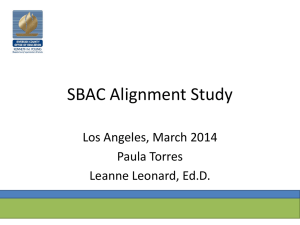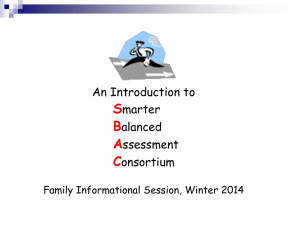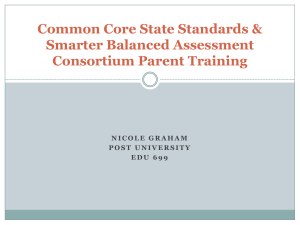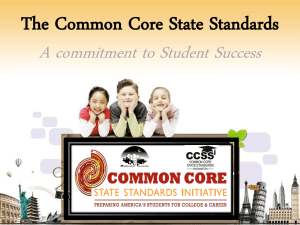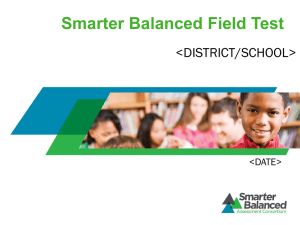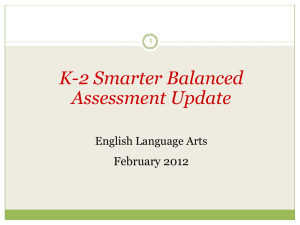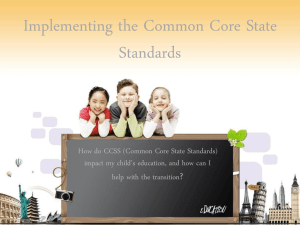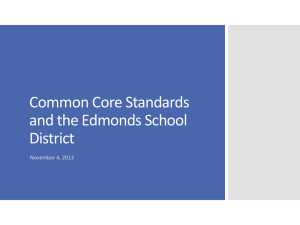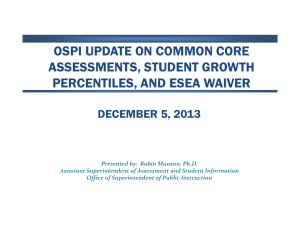COMMON CORE STATE STANDARDS
advertisement
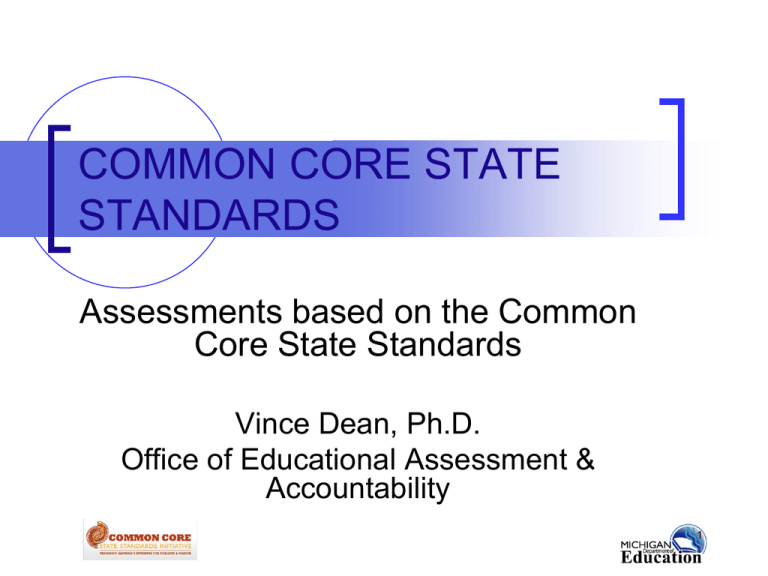
COMMON CORE STATE STANDARDS Assessments based on the Common Core State Standards Vince Dean, Ph.D. Office of Educational Assessment & Accountability 1 Race to the Top Assessment Competition Assessments based on the Common Core State Standards RTTT Assessment Competition 350 million total 320 million for at least 3-8 and one H.S. grade 30 million for H.S. solution, likely end-of-course Alternate Assessments based on Alternate Achievement Standards Grant Competition English Language Proficiency Grant Competition (next federal fiscal year) Race to the Top Assessment Competition Assessment Consortia Development of an infrastructure and content for a common assessment in measuring CCSS in English Language Arts and Mathematics Two consortia SMARTER/Balanced Assessment Consortium (SBAC) Partnership for the Assessment of Readiness for College and Career (PARCC) Race to the Top Assessment Competition U.S. Education Department Requirements Measure the full breadth of the Common Core State Standards Extend the range of high quality measurement in both directions Assessments operational by 2014-15 Consortia must offer an online version Must take advantage of technology for reporting speed and be instructionally relevant Race to the Top Assessment Competition The consortia: SMARTER/Balanced 31 states 17 governing states CAT beginning in 2014-2015 PARCC 26 states 11 governing states CBT beginning in 2014-15 Introduction to the SMARTER Balanced Assessment Consortium (SBAC) History Smarter Mosaic Balanced • Computer • Adaptive • Formative • Capacity • Integrated • System Smarter Balanced Assessment Consortium Governing States Advisory States CT, HI, ID, KS, ME, MI, AL, CO, DE,GA, IA, KY, MO, MT, NC, NM, NV, NH, NJ, ND, OH,OK, PA OR, UT, VT, WA, WI, SC, SD WV 17 14 Theory of Action Goal To ensure that all students leave high school prepared for postsecondary success in college or a career through increased student learning and improved teaching Theory of Action SMARTER Balanced Assessment Consortium shaped by the following principles: 1. Integrated system 2. Evidence of student performance 3. Teachers integrally involved 4. State-led, transparent and inclusive governance structure Theory of Action SMARTER Balanced Assessment Consortium shaped by the following principles: 5. Continuously improve teaching and learning 6. Useful information on multiple measures 7. Design and implementation adhere to established professional standards Theory of Action Creating a policy environment that supports: a. innovation systems, b. high expectations and c. increased opportunities for students Aligned to the Common Core Standards: a. b. c. d. e. clearly defined college and career expectations, learning progressions content/curricular frameworks, test maps, and instructional processes Theory of Action SBAC policies and standards are effectively communicated to districts and schools: a. Multi-media communications plan b. Score reports SBAC Specific Priorities Ensure all students have access to the technology needed to participate in each component (summative, interim/benchmark, formative) Support research on how to use technology to increase access for all students, in particular those needing accommodations SBAC Specific Priorities Use technology to efficiently deliver training, resources, reports and data; social networks for teachers to develop and disseminate effective CCSS curriculum and instructional tools Create innovative item types that utilize technology and represent realworld contexts SBAC Specific Priorities Use Computer Adaptive Testing engine to maximize accuracy for individual students across the CCSS Standardized accommodations policy and administration practices across states to ensure comparability SBAC Assessment Design Proposal SBAC Assessment Design Proposal Summative Assessment Measure full range of CCSS Computer Adaptive Testing for precision Timely results Engage Institutions of Higher Education to ensure achievement standards reflect college and career readiness Scale scores help inform growth model SBAC Assessment Design Proposal Interim Benchmark Assessment Allow for finer grain of measurement (e.g., end of unit) Inform teachers if students on track to be proficient on summative assessments Multiple opportunities for students to participate Scale scores help inform growth model SBAC Assessment Design Proposal Formative Assessment Repository of tools available to teachers to support quick adjustment and differentiated instruction Help define student performance along the CCSS learning progressions Concrete strategies for immediate feedback loops SBAC Assessment Design Proposal Teacher Engagement Integral role in developing test maps for each grade and content area Item writing, specifications, reviewing, and range-finding for all test types Teacher-moderated scoring of performance events to inform professional development Technology Enhanced Item Prototype items courtesy of the Minnesota and Utah Departments of Education Technology Enhanced Item Minnesota Science Item SBAC Assessment Design Proposal Assessment window vs. single day administration Multiple opportunities to assess Quick results available to support instruction Emphasis on problem-solving and critical thinking Alternate Assessments Based on the Common Core State Standards Dynamic Learning Maps Alternate Assessment Consortium State Participants Iowa Kansas Michigan Mississippi Missouri New Jersey North Carolina Oklahoma Utah West Virginia Wisconsin Other Participants University of Kansas Center for Educational Testing and Evaluation Center for Research Methods and Data Analysis Center for Research on Learning Special Education Department AbleLink Technologies The ARC The Center for Literacy and Disability Studies at the University of North Carolina at Chapel Hill Edvantia Feature Overview Learning maps Dynamic assessment Inclusion of instructionally relevant tasks Instructionally embedded and stand-alone versions Advanced feedback and reporting systems (including growth modeling) Technology platform Universal design Evidence centered design including cognitive labs Scaffolding Development of over 14,000 tasks/items Professional development Major Changes Include Moving Online Scoring Reporting Moving to Online Assessment Survey of state testing directors (+D.C.) 41 responses 5 of 41 states have no CBT initiatives 36 of 41 states have current CBT initiatives, including: Operational online assessment Pilot online assessment Plans for moving online Moving to Online Assessment Survey Of of state testing directors (+D.C.) 36 states with some initiative 21 states currently administer large-scale general populations assessments online 9 states have plans to begin (or expand) online administration of large-scale general populations assessments 8 states currently administer special populations assessments online 2 states have plans to begin (or expand) online administration of special populations assessments Moving to Online Assessment Survey of state testing directors (+D.C.) Of 36 states with some initiative 5 states currently use Artificial Intelligence (AI) scoring of constructed response items 4 states currently use Computer Adaptive Testing (CAT) technology for general populations assessment 0 states currently use CAT technology for special populations assessment 7 states offer online interim/benchmark assessments 7 states offer online item banks accessible to teachers for creating “formative”/interim/benchmark Online Assessment -The Michigan Stage Michigan’s Pilot online initiatives in 2006 Pilot in 2011 (English Language Proficiency) Pilot in 2012 (Alternate Assessments) Pilots leading up to operational adoption of SMARTER/Balanced Assessment Consortium products in 2014/15 Constitutional amendment barring unfunded mandates Scoring Maximize objective scoring by Automated scoring of objective items AI scoring of extended written response items, technology enhanced items, and performance tasks wherever possible Distributed hand-scoring of tasks not scorable using AI Scoring (maximize objective, distribute subjective) Scoring as Professional Development Human scorers taken from ranks of teachers Online training on hand-scoring Online certification as a hand-scorer Online monitoring of rater performance Validation hand-scoring of samples of AI-scored tasks Our experience with teacher-led scoring and rangefinding indicates that it is some of the best professional development that we provide to educators Reporting Current reports can be difficult to read and poorly used Need online reporting of all scores for all stakeholders, including: Policymakers (aggregate) Administrators (aggregate and individual) Teachers (aggregate and individual) Parents (aggregate and individual) Students (individual) Reporting Portal Reporting portal needs to be able to integrate reports from classroom metrics all the way to large-scale secure assessment metrics Overall achievement & growth scores Unit achievement scores Growth scores based on learning progressions Classroom achievement scores Challenges LEA capacity for online assessment Bandwidth issues, especially in rural areas Minnesota challenge Utah example USED working with FCC on National Broadband Initiative Challenges Item development for computeradaptive testing Field-testing Item types Demographic coverage AI Scoring validation Challenges Psychometrics Accommodated versions for SWD and ELL Comparability across years and student populations Equating from year to year Contrast, read aloud, enlarged print Braille All challenges will be resolved by 2014-15 Timeline for Transition 2010-2011 Getting to know the CCSS/Alignment work 2010 MEAP/2011MME remain the same State focus will be on technical assistance 2011-2012 Implementation of CCSS in classrooms 2011 MEAP/2012 MME remain the same State focus will be on instruction/professional development Timeline for Transition 2012-2013 2012 MEAP minimally modified as necessary to reflect the CCSS 2013 MME remains the same State focus will be on student learning 2013-2014 2013 MEAP based on 2012 model 2014 MME remains the same State focus will be on preparing for new assessments from SMARTER Consortium 2014-2015 Full implementation - Instruction and assessment based on CCSS Contact Information Office of Educational Assessment & Accountability www.michigan.gov/oeaa SMARTER Balanced Assessment Consortium http://smarter.k12partners.org/ DRAFT 471
